#Rural Bengal Life
Text
Tamarind Tree
Those were the impeccable times.
Thatched roof home,
cow-dung veneered verandah
stretched
from
the shallow pond
to the phani manasa shrub.
Grandmother appearing.
Two brinjals in hand. Two khadus on two wrists.
Jingling. Ironly cuffs.
Said, "These are yours now —
two young cows, you Badua!
Take them to the grazing field.
Protect them from Pashupati the bull.
Collect dung in an iron pail.
We will not cut
anymore this year a tamarind tree.
Only dry coconut shells, chaffs,
cow dung cakes
to boil
cauldrons of paddy.”
The two brinjals were burnt the same night
on the embers
of a two-mouth chuli.
Their violet skins peeled off,
revealing mouth watering meat.
The same year, my grandmother peed
on the verandah. On the mud it had made she slid,
to break her forehead
against her iron arm.
The vaidya prescribed a Chandrayan.
"Scant virtue, woman,
too much phlegm!
Yet, your silly heart beats!"
He roared kindly.
Crooked lips — red eyes —
three aunts circled in
from their in-laws’
by noon —
At nightfall, we downed a tamarind tree.
Glossary:
Phani Manasa: Indian prickly pear tree, Opuntia ficus-indica.
Khadus: Thick bangles.
Badua: The head of a village (affectionately used).
Chuli: An oven made by digging a hole in the ground.
Vaidya: An ayurvedic doctor.
Chandrayan: A Hindu ritual to wash off the sins of one who is soon to be deceased.
(The poem was first published in the Sahitya Akademi's ‘Indian Literature’ #326 in December, 2022)
#Poem#Potery#Childhood Memories#Fuel#Memories of My Grandmother#Poverty#Rural Bengal Life#Tamarind Tree#What burns and with what do you burn it?
2 notes
·
View notes
Text


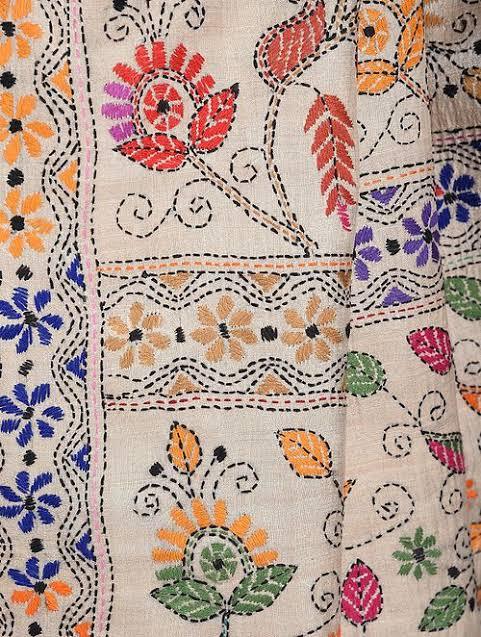




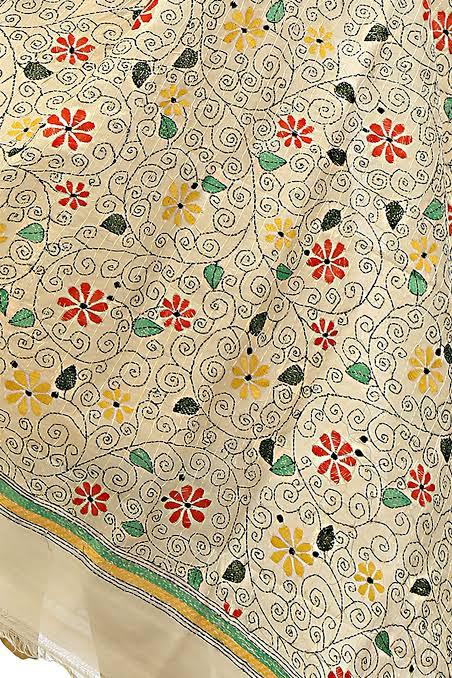

Kantha (Bengali: কাঁথা) is a form of embroidery originating in Bengal region, i.e. Bangladesh and the Indian states of West Bengal, Tripura and parts of Assam. It has its roots in nakshi kantha, an ancient practice among bengali women of making quilts from old saris and rags by sewing them together. In modern usage, kantha generally refers to the specific type of stitch used. The kantha needlework is distinct and recognised for its delicacy. The stitching on the cloth gives it a slightly wrinkled, wavy effect. Today, kantha embroidery can be found on all types of garments as well as household items like pillowcases, bags and cushions.
While it is an increasingly diversifying art form, traditional kantha embroidery motifs are still sought after. Traditional kantha embroidery is two-dimensional and are usually of two distinct types: geometric forms with a central focal point, carried over from the nakshi kantha tradition and influenced by islamic art forms; and more fluid plant, floral, animal and rural motifs with stick-figure humans depicting folklores and rural life in Bengal.
1 / 2 / 3 / 4 / 5 / 6 / 7 / 8 / 9 | textile series
#bangla tag#textiles#ots#kantha#nakshi kantha#bengal#bengali#bangladesh#india#embroidery#needlework#textile art#embroidery art#south asia#south asian
1K notes
·
View notes
Text
Gulf migration is not just a major phenomenon in Kerala; north Indian states also see massive migration to the Gulf. Uttar Pradesh and Bihar accounted for the biggest share (30% and 15%) of all Indian workers migrating to GCC1 countries in 2016-17 (Khan 2023)—a trend which continues today. Remittances from the Gulf have brought about significant growth in Bihar’s economy (Khan 2023)—as part of a migrant’s family, I have observed a tangible shift in the quality of life, education, houses, and so on, in Siwan. In Bihar, three districts—Siwan, Gopalganj, and Chapra—send the majority of Gulf migrants from the state, mostly for manual labor (Khan 2023). Bihar also sees internal migration of daily wagers to Delhi, Bombay, and other parts of India. Gulf migration from India’s northern regions, like elsewhere in India, began after the oil boom in the 1970s. Before this time, migration was limited to a few places such as Assam, Calcutta, Bokaro, and Barauni—my own grandfather worked in the Bokaro steel factory.
Despite the role of Gulf migration and internal migration in north Indian regions, we see a representational void in popular culture. Bollywood films on migration largely use rural settings, focussing on people who work in the USA, Europe, or Canada. The narratives centre these migrants’ love for the land and use dialogue such as ‘mitti ki khusbu‘ (fragrance of homeland). Few Bollywood films, like Dor and Silvat, portray internal migration and Gulf migration. While Bollywood films frequently centre diasporic experiences such as Gujaratis in the USA and Punjabis in Canada, they fail in portraying Bihari migrants, be they indentured labourers in the diaspora, daily wagers in Bengal, or Gulf migrants. The regional Bhojpuri film industry fares no better in this regard. ‘A good chunk of the budget is spent on songs since Bhojpuri songs have an even larger viewership that goes beyond the Bhojpuri-speaking public’, notes Ahmed (2022), marking a context where there is little purchase for Gulf migration to be used as a reference to narrate human stories of longing, sacrifice, and family.
One reason for this biased representation of migration is that we see ‘migration’ as a monolith. In academic discourse, too, migration is often depicted as a commonplace phenomenon, but I believe it is crucial to make nuanced distinctions in the usage of the terms ‘migration’ and ‘migrant’. The term ‘migration’ is a broad umbrella term that may oversimplify the diverse experiences within this category. My specific concern is about Gulf migrants, as their migration often occurs under challenging circumstances. For individuals from my region, heading to the Gulf is typically a last resort. This kind of migration leads to many difficulties, especially when it distances migrants from their family for much of their lifetime. The term ‘migration’, therefore, inadequately captures the profound differences between, for instance, migrating to the USA for educational purposes and migrating to the Gulf for labour jobs. Bihar has a rich history of migration, dating back to the era of indentured labor known as girmitiya. Following the abolition of slavery in 1883, colonial powers engaged in the recruitment of laborers for their other colonies through agreements (Jha 2019). Girmitiya distinguishes itself from the migration. People who are going to the Arabian Gulf as blue-collar labourers are also called ‘Gulf migrants’—a term that erases how their conditions are very close to slavery. This is why, as a son who rarely saw his father, I prefer to call myself a ‘victim of migration’ rather than just a ‘part of migration’. It is this sense of victimhood and lack of control over one’s life that I saw missing in Bollywood and Bhojpuri cinema.
— Watching 'Malabari Films' in Bihar: Gulf Migration and Transregional Connections
#bhojpuri indentured history#malayalam cinema#bihari labour migration#gulf migrant labour#malayali labour migration#bollywood cinema#bhojpuri cinema#nehal ahmed
15 notes
·
View notes
Text
Prothom Protishruti
The first novel of the trilogy "Satyabati" by Ashapurna Devi
In the book "Prothom Protishruti" or "The First Promise" the author tell us the struggles, sorrows, and efforts of women in 19th Century colonial Bengal. It starts off with the story of an Eight year old girl named Satyabati who stands up against the social norms, injustice and superstitions. The story is set in Nityendapur, a remote village of the then undivided Bengal. From an early age, Satyabati used to point out all the unfairness and injustice she witnessed which amazed her father, Ramkali. Being somewhat different and unusual than girls of her age, she was always on Ramkali's mind. Despite Ramkali's unwillingness, Satyabati who was married to Nabakumar was transferred to the home of her in-laws in Baruipur when she was only a Nine years old girl. Satyabati's mother-in-law's merciless abuse, maltreatment or the strict supervision, nothing stopped her from fighting to establish her own rights.
After many hardships in her life, Satyabati still wanted her children to become a good person, she wanted her youngest daughter to be what she couldn't. But was she really successful? Or the deity was only giving her false hopes? Was she able to keep the promise she made to herself? I believe this is what the book is about. This is a huge story with variety of realistic characters. From her bad-tempered mother-in-law Elokeshi to Nabakumar's teacher Bhabatosh Master or his cousin Saudamini, everyone had quite an impact in her life. Instead of being confined within the four walls, she broke the shackles of prejudices to experience the life she used to dream of.
“এতো আলো পৃথিবীতে, তবু পৃথিবীর মানুষগুলো এতো অন্ধকারে কেন?”
(There is so much light in this world, yet why do its people reside in so much darkness?"
From the very beginning of the novel, I was really really immersed in the story. I have to agree that Ashapurna Devi's storytelling is insane. The people felt so real like i can't help but wonder how she brought the then rural colonial bengal back to life. The customs and traditions, the change in people and nature, the beliefs everything feels so real like I've been there.
It was a 10/10. A HIGHLY RECOMMENDED BOOK!👏👏(It's available in English too) Can't wait to read the two other books of the trilogy, "Subarnalata" and "Bakul-Kotha".
#haven't read a good book like this in a while#absolutely loved it#Ashapurna Devi#Prothom Protishruti#desiblr#desi tumblr#bengblr#bengaliblr#bookblr#book review#book recommendations#book reccs#bangla
4 notes
·
View notes
Text
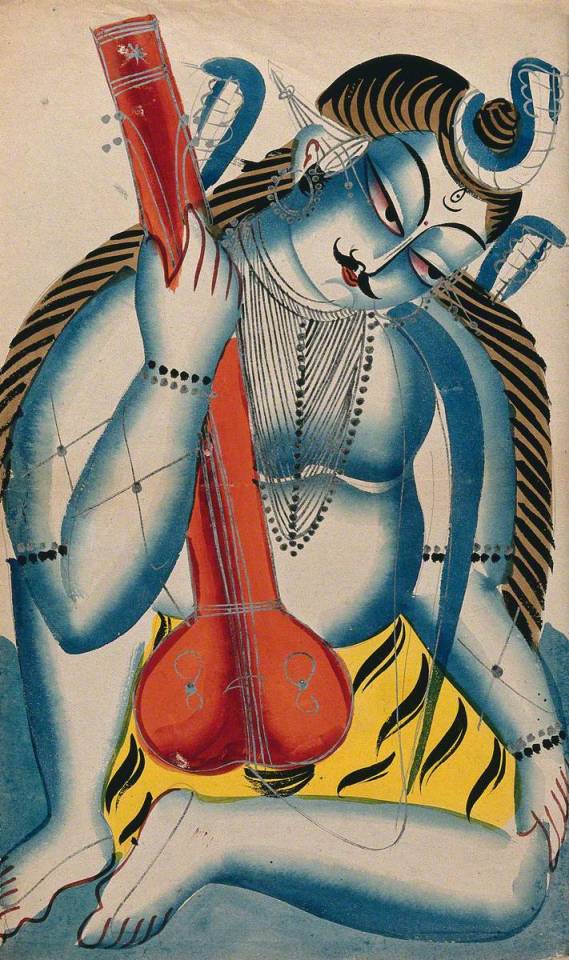




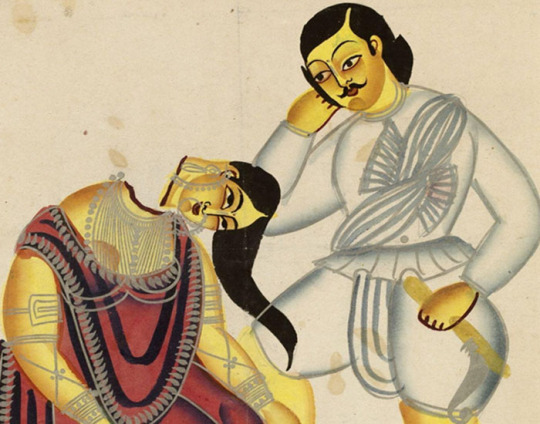

Kalighat Paintings- Modern Art Inspired by Life in Kolkatta.
Kalighat painting is a school of painting in Kalighat, a small district in Calcutta. It is named after the celebrated Hindu goddess Kali. Kalighat painting originated from the folkart tradition of rural Bengal. The Patuas or picture makers had migrated from Bengal in the early nineteenth century. There are a range of subjects from religious imagery of Hindu gods, goddesses and stories to natural history, social types and proverbs. The range of materials used in drawing are pencil, watercolour, indian ink and silver paint. The brushwork on these paintings are deemed by experts as deft, seamless, flowing and one of the smoothest art forms in India.
https://wellcomecollection.org/
10 notes
·
View notes
Text

68 Years of Pather Panchali (26/08/1955).
Pather Panchali also known as 'Song of the Little Road,' is a groundbreaking drama film directed by Satyajit Ray in his directorial debut and funded by the West Bengal Government, the film is based on a 1929 novel of the same name by Bibhutibhushan Bandyopadhyay. The cast includes mostly newcomers like Subir Banerjee, Kanu Banerjee, and Karuna Banerjee, among others. The film is the first installment in Ray's Apu Trilogy and explores the struggles of young Apu and his sister Durga as they navigate the hardships of rural life in a financially struggling family.
The film's production faced numerous challenges, including financial constraints and a largely inexperienced crew, and took almost three years to complete. Despite these obstacles, the film was shot primarily on location and featured a memorable soundtrack composed by sitar virtuoso Ravi Shankar, based on traditional Indian ragas. Subrata Mitra managed the cinematography, while Dulal Dutta took care of the editing.
After its initial screening at New York's Museum of Modern Art in May 1955, the film was released in Calcutta to critical and commercial success, although it didn't turn a significant profit until the early 1980s. It received accolades from both the Chief Minister of West Bengal and the Prime Minister of India. While the film has been lauded for its realism and emotional depth, some critics have found its pacing slow and have criticized its romanticized depiction of poverty.
Academic discussions around the film often focus on its lyrical and realistic storytelling, influenced by Italian neorealism, as well as its nuanced portrayal of the complexities and simple joys of everyday life.
The story of Apu continues in the subsequent films of the trilogy, 'Aparajito' (The Unvanquished, 1956) and 'Apur Sansar' (The World of Apu, 1959). 'Pather Panchali' is considered a milestone in Indian cinema, contributing to the Parallel cinema movement that emphasized authenticity and social realism. The film garnered international acclaim, winning India's National Film Award for Best Feature Film in 1955 and the Best Human Document award at the 1956 Cannes Film Festival, among other honors. It is frequently cited in compilations of the greatest films of all time and solidified Ray's reputation as a leading figure in Indian filmmaking.
5 notes
·
View notes
Text
Village tour experience in Bangladesh:
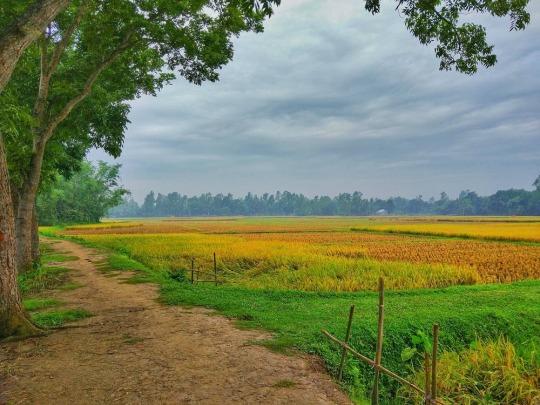
Who does not like the quiet atmosphere of the village after the busy city life. Mud roads, green fields full of crops, mud houses add another dimension to the village look. Today's presentation is about the experience of visiting such a village
Village Tour Plan:
I sometimes travel to different villages to taste a bit of freedom from this busy city life. Sometimes the village is part of the remote areas of Bangladesh and sometimes it is the different Pahari areas of Bangladesh.
As a result of traveling for so long, I have come to understand that, although the villages of each place have their own traditions, culture and lifestyle, villages are unique and unique in one respect. That is the uncomplicated mindset and the genuine kindness of nature. One thing to be noted is that like many other people of Dhaka, my family roots are rooted in the village.
The mind was also very tired of the hustle and bustle of urban life. So, I decided to travel to that small village Tarutia during the last Eid holiday.
Sirajganj is not very far from Dhaka travel route. Soon after the train left Dhaka city, the scenery on both sides began to change gradually. Once the familiar urban signs gradually disappeared, the green nature caught the eye.
First Day at Village House:
As soon as I reached the village, I noticed that the scenery here is more beautiful. Fields of various crops are scattered here and there. And the dense forest can be seen from a distance. After enjoying the sweetness of nature, I reached my village home in no time. I really felt the pull of my soul with them in that absolute hospitality.
I saw a unique form of nature in rural Bengal. Everywhere you look in rural Bengal, there is an abundance of greenery. The winding roads of the village fascinate us deeply. The immense softness in rural Bengal makes us fall in love with the village. no So the people of the city rush to our village Bangla for some leisure time. It is not counted how many poets and literary writers have written poems impressed by this sweet form of rural Bengal.
Finally:
I returned to my very familiar city life after spending several days in such a beautiful environment surrounded by free nature. I brought with me a whole lifetime of memories, and I left behind all the pride and hearty love of my urban life.
After returning, it was a bit uncomfortable to adapt to the busy life of the city for a few days. I decided to go back to my beloved village very soon to smell the earth near the bosom of nature. Until then, this experience of traveling to the village of Bangladesh will remain intact in my memory.
8 notes
·
View notes
Text
Sahaja Yoga Meditation
What is SAHAJA YOGA MEDITATION?
"Sahaja yoga meditation" define as inner spiritual growth as well as good health.
It filled with peace ,relaxation ,patience , and so on .
Most importantly ,"Sahaja yoga meditation " is famous all over the world .
Similarly ,it work with different source of medium for all individual.
Above all , availability of lots of video ,post, books and so on.
On the other hand ,they have lots of yoga videos .
lacking information available for all individual.
It connect with urban and rural people.
Benefits of "SAHAJA YOGA MEDITATION":-
True meditation and yoga provide lacking benefits for our health.
Firstly ,Early morning meditation with yoga gives healthy body .
Secondly ,It avoid illness.
Most importantly ,remove health issues problem from the body.
Proper functioning all body parts.
However ,it fulfill all requirement for healthy body .
Right meditation provide knowledgeable as well as sharpen mind.
On the other hand , increase thinking power.
However ,filled with positive mind avoid negative thoughts.
Above all ,it increase immunity power Reduces stress and weakness.
Moreover ,Give fruitful wisdom and also reduces sickness in body.
It provide fruitful wisdom for proper body growth.
"Sahaja yoga meditation" Centre in India:
Uttarakhand
West Bengal
Uttar Pradesh
Tripura
Telangana
Tamil Naidu
Sikkim
Rajasthan
Punjab
Nagaland
Odisha
Pondicherry
Manipur
Meghalaya
Mizoram
Kerala
Madhya Pradesh
Maharashtra
Jammu Kashmir
Jharkhand
Karnataka
Gujrat
Haryana
Himachal Pradesh
Daman and Diu
Delhi
Goa
Assam
Bihar
Chhattisgarh
Andaman Nicobar
Andhra Pradesh
Arunachal Pradesh
Sahaja yoga meditation steps:-
There are different steps are as follows:-
Firstly ,sit straight with relax mind.
close eyes and than ,create silence with your inner soul.
After that ,meditate with right concentration.
Good diet for good heath:-
Fresh air also a part of good health.
Similarly , eat fresh vegetables and fruits.
proper yoga and meditation.
On the other hand ,drink more and more water.
Most importantly ,avoid junk food.
In other words ,its harmful .
Else while ,take proper sleep.
Consequently ,use good oil for cooking.
Proper functioning digestive system.
Above all ,Good diet remove tiredness.
Meditation and yoga is important for good health and Most importantly, for proper functioning digestives system . Moreover ,drink more and more water and live life joyful.
#Sahaja Yoga Meditation#Meditation and Yoga#drink more and more water#proper functioning digestive system
2 notes
·
View notes
Text
KANTHA: AN ODE TO A HUMBLE WEAVE
Every great legend has a humble beginning, rags to riches, and a steady rise to fame. Veaves is on a journey to bring our beloved artforms to the spotlight as they are the ones that stitch history together in a beautiful tapestry. One such story is that of the famed Kantha embroidery that stitches together fragments of history as pieces of cloth to make a whole.
Embroidery as a craft has been in existence since time immemorial, evolving in various cultures across the world. While initially, it began as a process used to tailor, mend and reinforce cloth, it fostered the development of decorative sewing techniques, being popularised within societies. In India, the oldest tradition of stitching patchwork cloth started with Kantha.
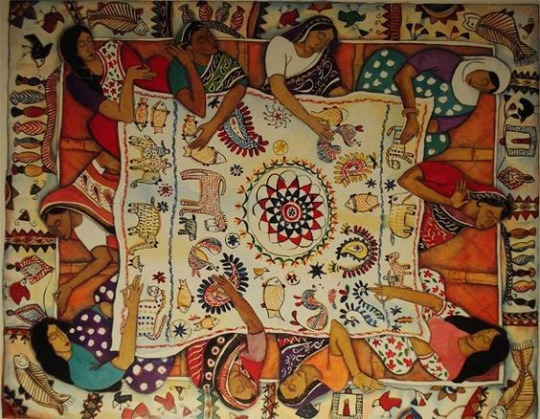
Believed to be derived from the Sanskrit word ‘kontha’ meaning rags is one of the oldest forms of embroidery originating from India, tracing its origins back to the pre-Vedic age (prior to 1500 BCE).
A simple running stitch, the arrangement of different materials in artistic patterns is what makes Kantha a complex design vocabulary. Like any textile tradition, Kantha was heavily influenced by the climate, geography, availability of materials, daily needs, culture and economic factors. Kantha was a way of breathing new life into old textiles as the labour of stitching fell mostly upon women who would pull together old cotton saris, dhotis and lungis to piece them together to make one discernable, utilitarian textile.

However, this quintessentially Indian craft had all but disappeared in the early 19th century before being revived in post-colonial India as a highly valued and admired art.
Kantha tells stories of culture, religion, folklore, practices, art and the lives of women within its stitch and layers.
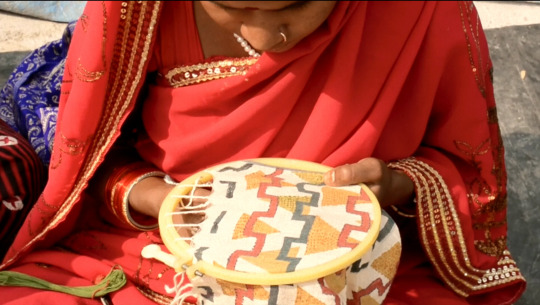
As an ambiguous stitch, Kantha gives free rein to the imagination with our own creativity being the limit. The process first begins by cutting the fabric in the desired shape and layering it for the required thickness. The artisan will then run a stitch delicately around the edges to hold the fabric layers together then proceeds to make the finer Kantha embroidery along one corner to the other.

With its humble beginnings in the rural villages of Bengal, the art form of Kantha was passed down from mothers to their daughters and now becoming a craft celebrated and practised by hundreds of South Asian women.
As a women dominated craft, Veaves believe that Kantha can empower women with a means to earn income. With more and more women breaking the glass ceiling and understanding the need for financial independence, finding a skill or occupation that can help support their family while upholding traditional artforms is a novel deed indeed. At Veaves, we aim at spreading the artforms among rural communities to help women contribute to the growth of their families. In turn, this will allow the education of more young girls without the burden of fending for their families and thereby lead to a future led by educated, bright and talented women.
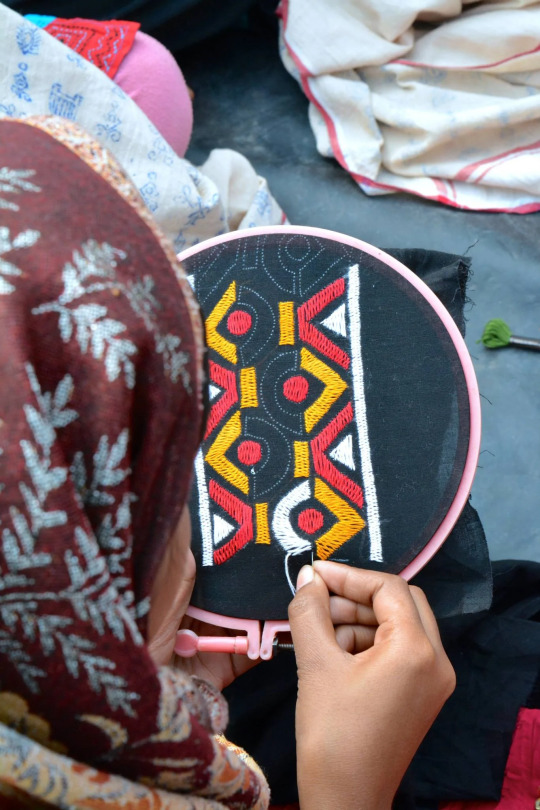
We, at Veaves, aim at supporting our weaving community, women and other minorities as they are the backbones of our nation. Therefore, making a purchase from Veaves is to support these communities and their hard work. We are on a mission to support the craft of rural Indian women. To tell their story, to support them and bring them back to the limelight of Indian artisanal craft. We work with the weavers, respecting their skill and labour while providing them with a platform to showcase their art and support them as we attempt to motivate you with urgency on how art forms such as weaving and embroidery, something as simple as this can help change lives.
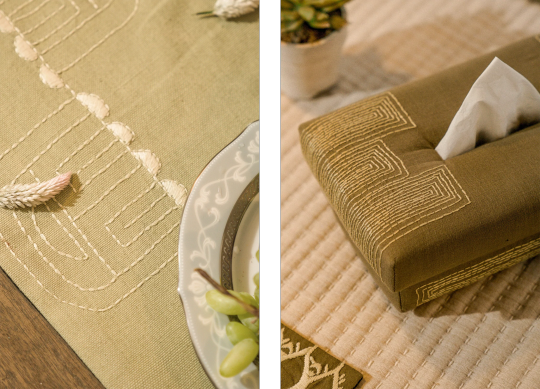
he elegant patterns that we have recreated run through simple geographic lines across cotton and silk fabrics at Veaves. Achieving this on sophisticated home essentials paves the way to a newly inspired look for your home. The cultured patterns of Kantha, woven together in time, bring home our heritage, adding a sense of character and culture deeply rooted in the history of India.
WRITTEN BY VATSALA CHOPRA
3 notes
·
View notes
Text
Jute's Despair to Multi-Industry Dominance
Ghanshyam Sarda, a name synonymous with Indian business success, wasn't always destined for greatness in the corporate world. The chairman of the Sarda Group of Industries, a multi-sectoral giant, started his journey far from the gleaming boardrooms.
Inspired by the enterprising spirit of the Marwari community, a young Sarda, though not a stellar student, dreamt of making his mark in the world of business. This dream materialized when he joined his family's jute business, a decision that laid the foundation for his remarkable ascent.
The Indian jute industry, particularly in West Bengal, was struggling during Sarda's early years. Labor unrest, government indifference, and a shrinking market threatened its very existence. Yet, Sarda, driven by a potent mix of familial legacy, unwavering passion, and a strategic mind, saw an opportunity. He felt a responsibility not just towards the business but also towards the countless workers who depended on it.
With years of relentless hard work and dedication, Sarda transformed the ailing jute industry. He breathed new life into the Sarda Group, steering it towards becoming a multi-sectoral powerhouse that employs over 80,000 people across India.
Sarda's success story holds valuable lessons for aspiring entrepreneurs. Here are some key takeaways:
Finding Purpose in Legacy: Sarda's story underlines the power of familial legacy. The jute business wasn't just a source of income; it was a tradition he was determined to uphold. This deep-rooted sense of purpose fueled his determination during challenging times.
Turning Challenges into Opportunities: The ailing jute industry could have been a deterrent for many. Sarda, however, saw the crisis as an opportunity to innovate and revive the sector.
Beyond Business: A Commitment to People: Sarda's focus wasn't solely on profit margins. He understood the human cost of a failing industry and strived to ensure the well-being of the workforce.
Sarda contributions extend beyond the corporate world. His philanthropic endeavors through the Chandakala Devi Trust reflect his commitment to giving back to society. The trust, named after his mother, focuses on education, particularly in rural areas.Ghanshyam Sarda journey is an inspiration for anyone who dares to dream big. It's a testament to the power of perseverance, strategic thinking, and a deep-rooted sense of responsibility. From the despair of the jute industry to the leadership of a multi-sectoral giant, Sarda's story is a saga of unwavering commitment and remarkable success
0 notes
Text
Bride, 1970
A new bride has come, the palanquin has left.
Those who’ve come late — the old viewers: grim.
Brittle-finger mothers measure the skin
of the girl. Her ornaments’ weight. Hair. Teeth.
The onlookers grow. This new girl’s laugh —
Tell me, tell me, ma, will she be tame?
Will she not blind our boy (for how long they themselves
could)? But a new girl shall possess new new tricks!
Carrying paddy from the paddy fields to the paddy pots,
pots to the oven. Oven to the mill.
The animals of the flower-bed night bathe
the cattle, feed the cattle, smell of cow urine.
Love. Who calls its obtuse name? The clarinet calls.
At the midnight play, Majnun bawls. The girl, too, weeps with him.
Till her man appears. To bring her — to bed.
Till the birds cackle, the sun appears. The girl wakes up to sweep
the floor for another ten years.
Now when the cowshed is clean, her daughter goes there to read.
(The poem was first published in the May 2023 issue of Poetry India: https://www.ethosliterary.org/poetry-india/may-2023-issue/poems-by-arun-paria)
#Poem#Poetry#Agrarian Life#Poverty & Education#Poverty & Love#Rural Bengal Life#Rural India#Rural South Bengal 1970#The Life of a Farmer Woman#Woman Marriage Emancipation
0 notes
Text


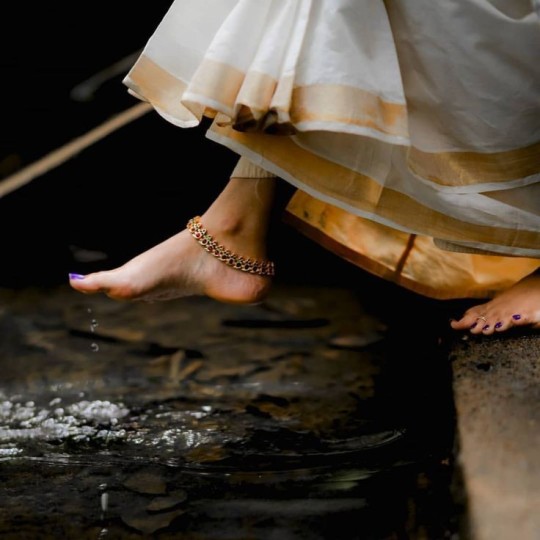
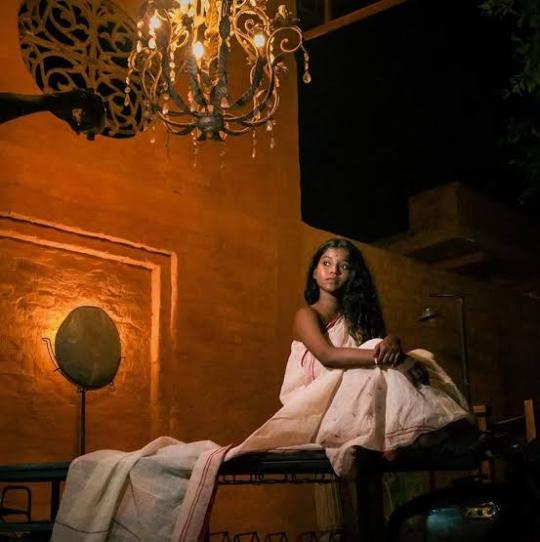



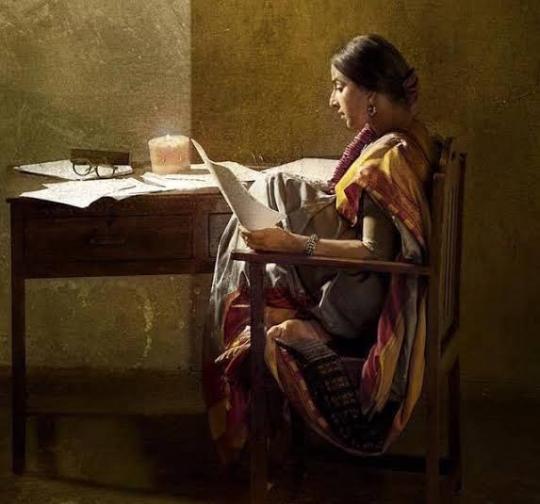
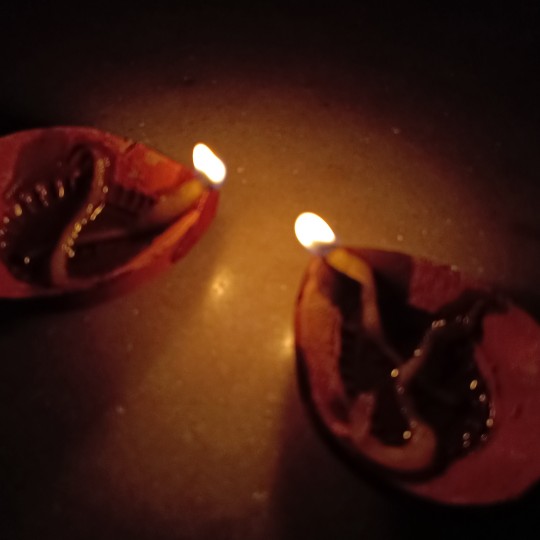
Khona was a poet and astronomer from Deulia village in Bengal, best known for Khonar Bochon, a series of couplets and short rhymes which imparts advice regarding agricultural and rural life. Born somewhere between 800-1200 A.D., Khona defied social and cultural norms of her time when women were rarely taught to read. Her husband Mihir was the son of the philosopher and astronomer Barahmihir, who was one of the navaratnas (nine gems) at the court of Chandragupta II. Khona lived in Chandragupta's court in Pataliputra for a time with her husband and father-in-law. According to legend, Chandragupta was so impressed with Khonar Bochon which benefited the farmers of his state that he named Khona the tenth gem of his court. Khonar Bochon remains relevant to the agricultural life of rural Bengal to the present day.
ষোল চাষে মূলা / তার অর্ধেক তুলা / তার অর্ধেক ধান / বিনা চাষে পান।
Translation: After 16 days of cultivation, radish cultivation in that land gives good yield. Cotton land requires 8 days of cultivation, paddy land after 4 days of cultivation gives good yield. Betel does not require cultivation.
1 / 2 / 3 / 4 / 5 / 6 / 7 / 8 / 9
#mb#khona#khonar bochon#khana#bengali academia#bangla tag#bangladesh#india#desi academia#dark academia#desi aesthetic#desi tag#desi tumblr#desiblr#bengali#indian history#ancient india#khonar bochor for anon#bengali literature
374 notes
·
View notes
Text
Exploring the Timeless Craftsmanship of Kantha Stitch: A Fusion of Art and Tradition

Kantha stitch, an age-old embroidery technique originating from the eastern regions of the Indian subcontinent, holds a unique place in the realm of textile artistry. Evolving from the rural landscapes of Bengal, this exquisite craft has transcended its humble beginnings to become a symbol of tradition, creativity, and timeless elegance.
In this article, we delve into the intricate world of Kantha stitch, exploring its history, significance, and contemporary resurgence in the form of diverse, captivating items. Origins and History: Bangalore Silk Kantha Stitch Saree can be traced back centuries, with its origins deeply intertwined with the cultural tapestry of Bengal.
Historically, Kantha referred to a type of quilt made from old saris and dhotis, with women in rural communities layering these discarded fabrics and employing simple running stitches to create functional blankets. Beyond its utilitarian purpose, Kantha quilts held deep emotional significance, often passed down through generations as heirlooms, adorned with motifs symbolizing folklore, mythology, and everyday life. Technique and Artistry: At the heart of Kantha stitch lies its simplicity and versatility. Traditionally, artisans would use a simple running stitch, known as "kantha stitch," to sew layers of fabric together, creating intricate patterns and designs.
Over time, the repertoire of stitches expanded to include variations like the "dokra" (double-sided) and "lepti" (wave) stitches, adding depth and texture to the artwork. The choice of motifs and colours is a reflection of the artisan's creativity and often draws inspiration from nature, mythology, and everyday life. Significance and Symbolism: Beyond its aesthetic appeal, Kantha stitch carries deep cultural and social significance. Historically, women in Bengal would create Kantha quilts as a form of self-expression and empowerment, using the craft to tell stories, express emotions, and assert their identity.
The motifs embroidered onto these quilts often held symbolic meanings, representing blessings for prosperity, protection from evil spirits, or celebrating life's milestones such as marriage and childbirth. In contemporary times, Kantha stitch continues to serve as a means of preserving cultural heritage, fostering community bonds, and empowering women artisans.
Contemporary Resurgence: In recent years, there has been a renewed interest in Kantha stitch, both within India and on the global stage. Artisans and designers are exploring innovative ways to incorporate Kantha embroidery into a wide range of products, from clothing and accessories to home decor and furnishings. The unique blend of traditional craftsmanship and modern aesthetics has made Kantha Stitch Silk Dupatta items highly sought after by discerning consumers who value authenticity, craftsmanship, and sustainability.
Conclusion:
In an age dominated by mass-produced goods, Kantha stitch stands as a testament to the enduring appeal of handmade craftsmanship. Its rich history, cultural significance, and timeless beauty continue to captivate audiences around the world, serving as a bridge between the past and the present. Whether adorning a luxurious silk scarf or gracing the walls of a contemporary home as a piece of art, Kantha stitch items carry with them the legacy of generations past, infusing every stitch with a story waiting to be told
1 note
·
View note
Text
Top 10 Surreal Experience In Jim Corbett National Park
If you are planning a weekend vacation to take a break from your busy schedule, Jim Corbett is one of the best places to visit in Uttarakhand with your family for a picnic. This renowned public park is at Ramnagar town in Uttarakhand's Nainital Area. With the reference of the name of Jim Corbett, the one picture that comes immediately to our brain is of Royal Bengal tigers, which are topmost attractions among other creature and bird species.
Jim corbett is not confined to Royal wildlife but also includes the striking features like waterfall, springs, scenery, waterfall and other attractions too. It is home to various species of flora and fauna .
Let’s explore top tourist spots in Jim Corbett.
Corbett Museum
If you are keen seeker of paintings & colors, then you have to pay visit to Corbett Museum, known to be the home of man-eater hunter turned conservationist in Jim Corbett. It is located in Kaladhungi, in Uttarakhand, this museum is actually a heritage place, where one can explore his personal belongings, including articles penned by him.
Wildlife Art Gallery
Wildlife Art Gallery is exciting space for art & nature admirer . You got chance to have look on the beautiful pictures taken by renowned wildlife photographer
Mrs. Deep Rajwar. It is worth visiting with your art-lover partners. You can shop for mementos as a token of visit.
Bijrani Forest
Bijrani forest is striking place, with attractions like dense forests, wildlife, & grasslands. It is the dry zone with diverse vegetation. It served as hunting ground for East India Company. Here, one can experience elephant safari too. If you are planning trip to Corbett, you must try the ASIA’s first Cave Theme Resort ,BRYSCAVES . They provides you the taste of luxury stays and best prices to safari with great experience and wildlife encounters.
Kyari Camp
You may experience a typical rural life without power at this unique camping spot. But kerosene and solar lights are available at night to light the entire space. Numerous outdoor pursuits, such as hiking routes, planting vegetables on farms, rappelling waterfalls, swimming in river pools, and even rock climbing, are available in the morning.
Garjiya Devi Temple
Garjiya Devi Temple is dedicated to the goddess Garjiya. This temple is settled on a big rock near the Kosi River. The span to pray and visit temple is during Kartik Purnima.
Sitabani Temple
As name of this temple suggest it is dedicated to Devi Sita from Ramayana. According to a mythology ,during Devi Sati’s Agnipariksha, she spent her days at this place. Tourist can visit and embibe the energy of greatest god Lord Rama and Devi Sati.
Dhangarhi Museum
It is spotted near the Dhangarhi Gate, a popular spot to visit Jim Corbett. It’s striking attraction is display of hunted wild animals. And you can buy handicraft articles as token of remembrance .
Jhirna Zone
Jhirna Zone lies in thick forested area , here one might be lucky to spot animals in their natural habitat include spotted deer, nilgai, wild elephants, sloth bears, & sambar deer.
Dhikala Zone
Dhikala Zone is to enjoy an incredible wildlife experience. You can opt for Canter Safari with reference of Best 5 star resort in Jim Corbett, BRYSCAVES, which guides you in dense jungle areas for surreal sightseeing with greatest discount possible.
Corbett Falls
If you are someone who is seeker of aesthetics natural scenic views ,you must visit waterfalls, which is surround by dense forests, which enhances its natural beauty. One can hire a bus or a taxi to reach waterfall.
Book Your Stay in the ASIA’s first cave theme resort in Jim Corbett
To experience surreal travel staycation at Best Family Resort in Jim Corbett, it is vital to plan your Itinerary & it must include , Bellmont Caves (formerly known as Brys Caves ) Best 5 Star Resort in Jim Corbett national park offers a rich stay with 40 extravagant rooms. Appreciate exclusive exercises like a soundproof disco, restoring spa, and different indoor games. The retreat flaunts current offices including conference and banquet hall, alongside a rambling lawn for outside occasions and relaxation.
In the heart of Jim Corbett's pristine wilderness lies a sanctuary of love and luxury – Brys caves. With its unparalleled beauty, world-class amenities, and unmatched hospitality, it stands as the ultimate destination wedding resort in Jim Corbett.
At Best Resort with spa in jim corbett, we understand that wellness is a deeply personal journey. That's why we offer personalized wellness programs designed to address your specific health and wellness goals. Whether you're seeking stress relief, weight management, or holistic healing, our experienced wellness experts will guide you on your path to optimal health and vitality.
In conclusion,
Bellmont Caves (formerly known as Brys Caves), 5 Star Resort in Jim Corbett stands out as the ultimate destination in Jim Corbett, offering luxury, adventure, and unparalleled natural beauty.
#best 5 star resorts#luxury resorts in jim corbett#best destination wedding in jim corbett#best spa in jim corbett
0 notes
Text
The Art of Storytelling
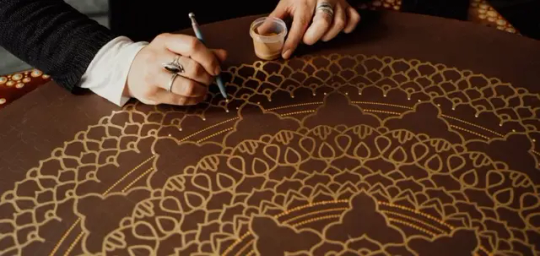
In this article, we embark on a journey to explore the enchanting world of Indian folk and tribal art, where stories come to life through brush strokes, intricate designs, and mesmerizing patterns.
The Mosaic of Folk and Tribal Art
India’s folk and tribal art forms are as diverse as its people and traditions. From the intricate Madhubani paintings of Bihar to the exuberant Warli art of Maharashtra, the flamboyant Pattachitra of Odisha to the vibrant Gond art of Madhya Pradesh, the canvas of Indian folk art is kaleidoscopic. Each form carries a unique story, a slice of history, and a piece of life.
These art forms are not confined to canvas or paper; they adorn walls, floors, and even textiles. They narrate tales of daily life, rituals, myths, and legends with a profound connection to nature and the spiritual world. It is through these art forms that generations have preserved their cultural identity, transcending language barriers and the sands of time.
Folk and Tribal Artists as The Storytellers
The custodians of this rich tradition are the skilled artists who create these masterpieces. Often hailing from marginalized communities and remote villages, these artists connect profoundly with their art. They learn from their elders, observing and imitating the techniques passed down through generations. Their art is not just a livelihood but a means of preserving their heritage.
Artists like Jangarh Singh Shyam, Jivya Soma Mashe, and Bhuri Bai have taken their traditional Gond and Warli art to international platforms, garnering recognition and acclaim. Their stories are a testament to the power of art in transcending borders and creating a global impact.
Visual Stories of Daily Life
Folk and tribal art celebrate every day, capturing the mundane in a mesmerizing manner. Scenes of rural life, agriculture, and the bustling village market come alive through these art forms. The portrayal of women fetching water from the well, farmers toiling in the fields, or tribal celebrations and rituals all encapsulate the essence of rural India.
For instance, Warli’s art, characterized by its rudimentary style and simple geometric shapes, depicts scenes of marriage, harvest, and the connection between humans and nature. These visual narratives often represent the artist’s perspective on life, embodying their worldview, aspirations, and reverence for their surroundings.
Myths and Legends on Canvas
Myths and legends, handed down through generations, find a vivid expression in folk and tribal art. These art forms are a repository of ancient stories, many of which revolve around gods, goddesses, and mythical creatures. Through intricate detailing and bold strokes, artists breathe life into these tales.
In Odisha’s Pattachitra, one can witness the epic stories of Lord Jagannath, Krishna, and other Hindu deities. These paintings often adorn the walls of temples, adding a sacred dimension to their artistic beauty. The blending of spirituality and art is a remarkable feature of these art forms.
Nature as Muse
Nature has always been a recurring theme in folk and tribal art. Artists draw inspiration from their immediate surroundings, showcasing the flora and fauna that are an integral part of their lives. Trees, birds, animals, and the elements are meticulously depicted, reflecting the harmony and dependence between humans and nature.
The Santhal tribes of West Bengal, for example, are known for their depictions of nature and animals in their Sohrai and Khovar art. Through vibrant patterns and bold colors, they express their deep connection to the earth and the creatures that share their habitat.
Reviving the Past, Paving the Future
While these art forms have a rich and timeless history, they have not remained stagnant. In an era of globalization, these art forms have evolved and adapted to new mediums and audiences. Artists are experimenting with modern materials, such as canvas and acrylics, to cater to a broader market.
Non-governmental organizations and government initiatives have played a significant role in preserving and promoting folk and tribal art. They provide artists with training, exposure, and access to global markets, ensuring these traditions thrive.
Blog: https://theknowledgereview.in/the-art-of-storytelling/
Credit: https://theknowledgereview.in/
#EducationLeadersinIndia#BestEducationalMagazineinIndia#TopEducationMagazine#EducationalMagazineinIndia
1 note
·
View note
Text
The We Foundation: Empowering Families, Building a Better Future
Across India, millions grapple with challenges that hinder their ability to thrive. The We Foundation, a leading healthcare NGO in India, steps in to address these very issues. Their focus? Empowering families by tackling health, education, and livelihood concerns.
Health: A Foundation for Wellbeing
The We Foundation recognizes that good health is the cornerstone of a fulfilling life. They work tirelessly to ensure access to quality healthcare, particularly for those in underserved communities. Their initiatives include:
Safe Drinking Water: Providing clean drinking water to rural households is a priority. They also promote water conservation practices in urban areas.
Combatting Water Contamination: The We Foundation addresses the critical issue of fluoride and arsenic contamination in water sources, safeguarding communities from health risks.
Comprehensive Healthcare Solutions: They collaborate with government agencies and other organizations to deliver a wide range of healthcare services.
Education: Nurturing Young Minds
The We Foundation believes that education is the key to unlocking a brighter future, especially for underprivileged children. Their programs target:
Improved Access to Education: They strive to bridge the gap by providing educational opportunities for children who might not have access otherwise.
Empowering Youth: The We Foundation equips young people with the skills and knowledge they need to become active and empowered members of society.
Livelihood: Building Self-Sufficiency
The We Foundation understands the importance of financial security. Their livelihood programs aim to:
Uplift Communities: They provide training and resources to help families build sustainable livelihoods, fostering economic independence.
Promoting Self-Reliance: The We Foundation empowers individuals with the skills and knowledge needed to generate income and support themselves.
By addressing these core areas, The We Foundation paves the way for a healthier, more educated, and self-sufficient future for countless families across India.
If you're looking for an NGO in India for healthcare, ngo for poor child education, or simply an organization making a significant difference in people's lives, The We Foundation is a worthy cause to consider supporting.
The We Foundation: Frequently Asked Questions
What are The We Foundation's areas of focus?
The We Foundation is a holistic NGO working in healthcare, education, and livelihood development. They address critical issues like access to clean water, sanitation, education for underprivileged children, and vocational training for sustainable income generation.
How can I donate to The We Foundation?
You can visit The We Foundation's website https://twfind.org/ to explore donation options. They accept contributions to support their ongoing programs and empower communities across India.
Does The We Foundation operate in my area?
The We Foundation has a presence in several Indian states, including Delhi, Mumbai, Odisha, Assam, and West Bengal. You can check their website for a more comprehensive list or to inquire about their programs in your specific region.
How can I volunteer my time with The We Foundation?
The We Foundation welcomes volunteers who share their passion for social change. Explore their website or contact them directly to learn about volunteer opportunities and see how your skills can contribute to their mission.
Is The We Foundation a reputable organization?
The We Foundation is a registered non-profit organization in India. You can find more information about their work, mission, and financial transparency on their website.
0 notes